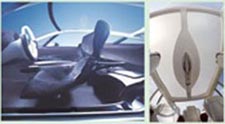SXSW: Futures Lab + Convergent Automobile Tech

Cool Hunting's in Austin, Texas this week to check out SXSW and all the related goings-on. With a bursting line-up that includes Interactive, Film and Music conferences, screenings, live music, tradeshows, and parties, it's no wonder that registration's rumored to be up by 50% this year. Here's the first of our reports from the frontlines of SXSW 2006.
Since landing in Texas, the How to Develop Digitally Convergent Technologies for Cars and a follow-up chat with panelist and Austin-based The Futures Lab founding president Derek Woodgate—showed us that gadgets like GPS-based devices are only the very first steps toward making driving a safer, more comfortable, and more convenient experience for tomorrow's road warriors.
Get Woodgate's take on cars that drive themselves and how your car may someday respond to your mood, after the jump.
Ambi-tainment
Focused on making time behind the wheel more visually and aurally enjoyable, innovations like transparent A-frames (the outside structure of the vehicle) that alter space perception, create appealing alternatives to actual larger vehicles such as multi-problematic SUVs. Differing from infotainment, Woodgate’s looking to windows that darken at the press of a button, modular systems, OLEDs to change where lights are put in the car, “drive by wire” digital driving that creates space by eliminating steering columns, and zonal controls, like acoustic baffling, to control sounds and even odors.
Immersive Technologies
These ambient benefits are the result of what Woodgate terms “immersive technologies”—features that involve drivers and passengers in the driving experience, and thus the technologies themselves, in new ways.
Innovative Familiarity
Immersive technologies require design that takes the entire driving experience (namely how drivers interact with existing designs) into consideration, meaning that existing spaces (like mirrors and dashboards) will provide different types of imagery. Colored guide lines or dots that are integrated into mirrors are one example of ways convergent technologies may show up in future models.
Driving Utopias
X-ray based seat technologies that adapt to driver stress levels and physical forms or automatic adjustments according to weather and traffic conditions, mean that commuters faced with increasingly complex driving conditions will at least find the overall experience more rewarding, if not vastly safer, more convenient, and more comfortable.











